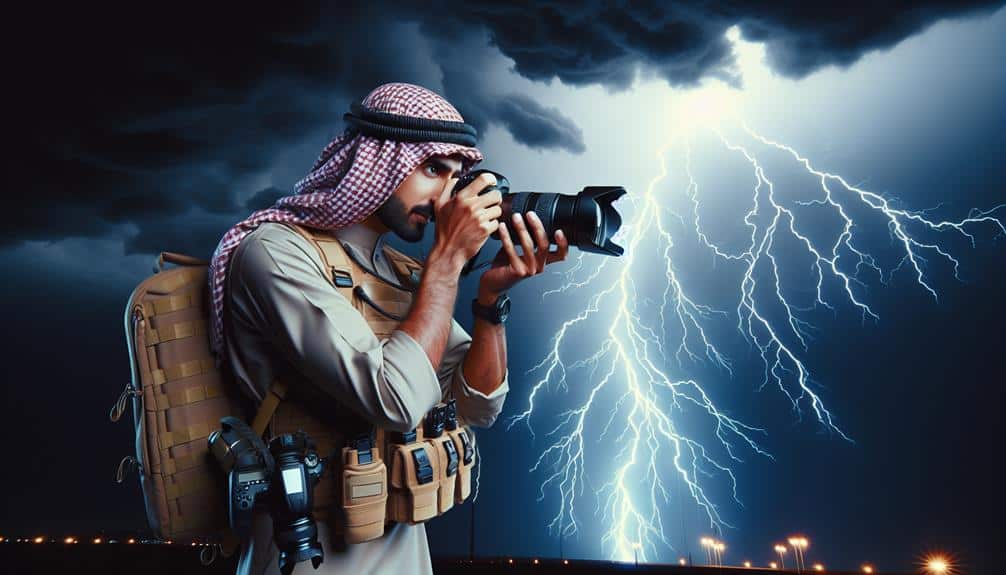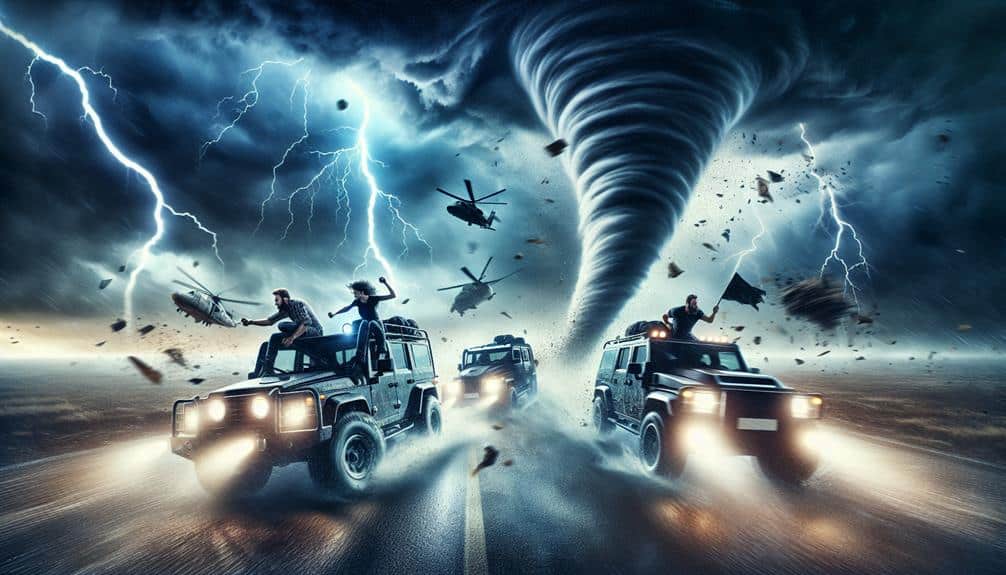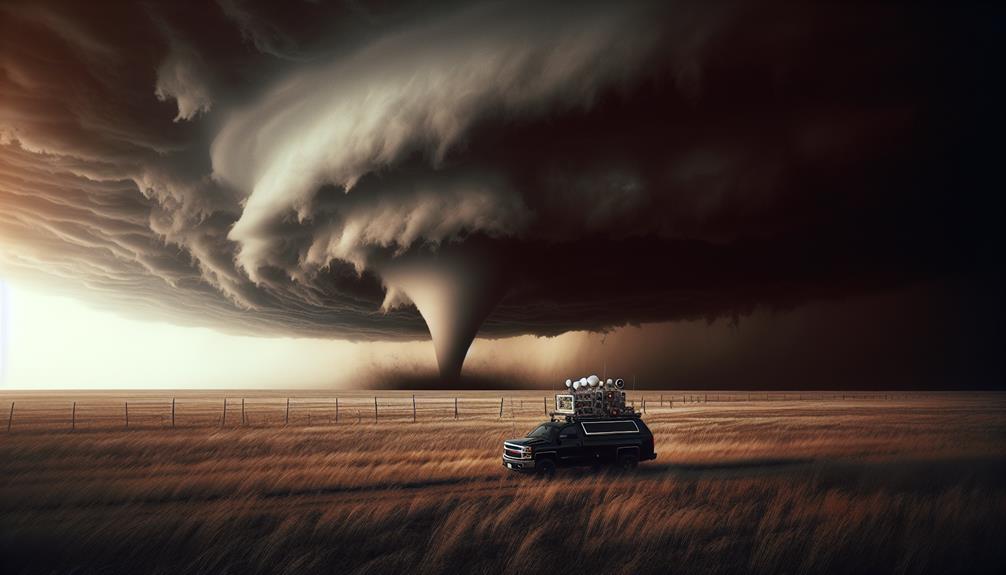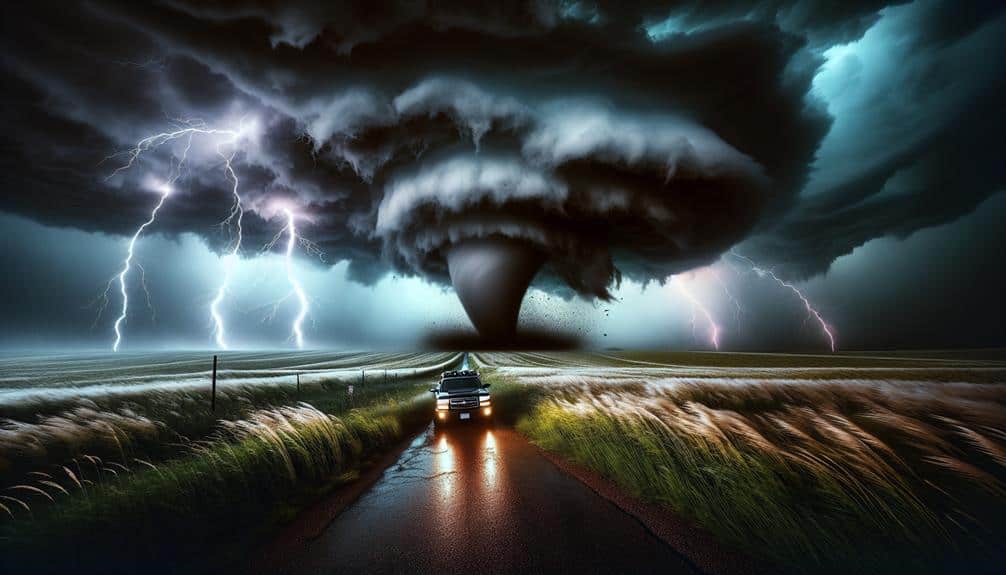When storm chasing, we must rigorously prioritize safety, meticulously plan, and continually assess risks in real-time. Guaranteeing legal compliance by adhering to local laws and acquiring necessary permits is vital. We need to minimize our environmental impact by implementing sustainable practices and adopting a leave-no-trace policy. Additionally, maintaining professional conduct, respecting local authorities, and carefully managing social media sharing fosters a positive reputation and supports scientific endeavors. These best practices safeguard not only our wellbeing but also the integrity of our storm-chasing activities. By following these guidelines, we ensure responsible and ethical participation in this thrilling field. Discover more in the full guide.
Key Points
- Always prioritize safety through meticulous planning, adherence to protocols, and thorough risk assessments.
- Comply with local laws, including road use regulations and protections for wildlife and habitats.
- Obtain necessary permits by researching local regulations and maintaining updated documentation.
- Minimize environmental impact with sustainable practices and a leave-no-trace policy.
Prioritize Safety First
Ensuring safety during storm chasing demands meticulous planning, adherence to established protocols, and constant situational awareness. We must conduct a thorough risk assessment before embarking on any pursuit. This includes analyzing weather models, understanding storm dynamics, and identifying potential hazards. Our risk assessment isn't just about the storm itself; it encompasses road conditions, visibility obstacles, and possible emergency scenarios.
Emergency preparedness is critical. We need to have a well-stocked emergency kit, including first aid supplies, food, water, and communication devices. Additionally, our vehicles should be maintained to handle severe weather conditions, equipped with GPS and alternate route maps. By planning for the worst-case scenario, we ensure we're ready to respond swiftly and effectively.
We can't underestimate the importance of real-time data. Utilizing advanced radar systems and mobile apps provides up-to-the-minute information, enhancing our situational awareness. This data-driven approach enables us to make informed decisions, reducing unnecessary risks.
Above all, our safety protocols must be non-negotiable. Regular drills and briefings ensure everyone knows their role and how to act in emergencies. Prioritizing safety doesn't restrict our freedom; it ensures we can continue storm chasing responsibly and sustainably.
Respect Local Laws
Adhering to local laws during storm chasing is vital for maintaining legal and ethical standards in our operations. When we abide by local laws, we make sure that our activities aren't only safe but also respectful to the communities we engage with. It's important to understand that storm chasing can impact local infrastructure and emergency services, and non-compliance can lead to severe legal consequences.
Data from various jurisdictions indicate that many regions have specific laws regarding road use during severe weather events. For instance, some areas may restrict access to certain roads to prioritize emergency vehicles. By showing respect for these regulations, we contribute to an organized and effective emergency response, minimizing potential disruptions.
Moreover, local wildlife and natural habitats can be affected by storm chasing activities. We need to follow local laws that protect these environments to avoid causing unintended harm. Compliance also fosters a positive relationship between storm chasers and local authorities, which can be advantageous for future endeavors.
Obtain Necessary Permits
Securing the necessary licenses for storm chasing operations is vital to guaranteeing compliance with local regulations and access to restricted areas. When we set out on our storm chasing expeditions, we need to follow a systematic approach to meet all legal requirements. This not only protects us but also guarantees we can continue our activities without legal interruptions.
Here are three crucial steps in the permit application process:
- Research Local Regulations: Each jurisdiction may have different legal requirements for storm chasers. It's important to understand the specific permits needed, which can vary from access licenses to special use authorizations.
- Submit Detailed Permit Applications: When applying for licenses, thorough information is key. This includes our planned route, the duration of our chase, and the specific areas we intend to access. Detailed applications reduce the chance of delays or rejections.
- Maintain Updated Documentation: Keeping our licenses and related documents up to date ensures we remain compliant with evolving regulations. This includes renewing licenses as required and staying informed about any legal changes.
Minimize Environmental Impact
Reducing our ecological footprint during storm chasing involves implementing sustainable practices and adhering to scientifically-backed guidelines. By integrating these practices, we can enjoy the freedom of storm chasing while minimizing our environmental impact.
One fundamental approach is to reduce waste. We should adopt a leave-no-trace policy, guaranteeing that all waste generated during our expeditions is properly collected and disposed of or recycled. This not only keeps our chasing grounds pristine but also lessens the risk of contaminating natural habitats.
Our conservation efforts should also extend to fuel consumption. By optimizing our travel routes and carpooling with fellow chasers, we can significantly lessen our carbon emissions. Utilizing fuel-efficient vehicles and maintaining them in top condition further enhances our environmental responsibility.
Additionally, we should leverage technology to minimize unnecessary travel. Real-time data and advanced forecasting tools enable us to pinpoint storm locations with greater accuracy, reducing the need for extensive driving.
Moreover, respecting wildlife and natural vegetation is paramount. We must avoid disturbing local flora and fauna, adhering to designated roads and paths. By doing so, we guarantee that our presence doesn't disrupt ecosystems, maintaining the natural balance.
Through these efforts, we demonstrate that storm chasing can coexist with environmental stewardship.
Maintain Professional Conduct

Maintaining professional conduct during storm chasing guarantees safety, integrity, and the credibility of our observations and data collection. By adhering to established guidelines, we enhance our contributions to the scientific community and safeguard our own protection.
Here are three key practices to ponder:
- Social Media Etiquette: We should exercise caution when sharing real-time data and images. Avoid sensationalism and verify that our posts provide accurate, verified information. This not only upholds our professional reputation but also prevents public panic and misinformation.
- Professional Attire: Dressing appropriately for storm chasing activities is essential. Proper attire includes weather-resistant clothing, safety gear, and identification badges. This not only ensures our safety but also signals our professionalism to both the public and emergency services.
- Respect for Local Authorities and Property: Always coordinate with local authorities and respect private property. This includes obeying road closures, not trespassing, and offering assistance if needed. Our cooperation fosters a positive relationship with the communities we observe, which can be crucial during emergencies.
Frequently Asked Questions
What Equipment Is Essential for a Successful Storm Chasing Expedition?
Did you know 70% of storm chasers rely on advanced safety gear and communication devices? We need vehicle modifications and photography equipment to capture data effectively and guarantee our safety while chasing extreme weather phenomena.
How Can Storm Chasers Stay Informed About Weather Conditions in Real-Time?
We can stay informed about weather conditions in real-time by utilizing advanced weather monitoring tools. These include radar systems, satellite imagery, and mobile apps that provide real-time updates, ensuring we have the freedom to make informed decisions.
Are There Any Storm Chasing Organizations or Communities to Join?
A rising tide lifts all boats. By joining storm chasing organizations, we enhance community involvement and safety. These groups provide networking opportunities and support, helping us stay informed and prepared while embracing the freedom of the chase.
What Training or Certifications Are Recommended for Novice Storm Chasers?
When considering storm chasing, let's prioritize safety first. Obtaining professional guidance through meteorological training and certifications, such as the SKYWARN program, guarantees we're well-prepared. Advanced courses in severe weather prediction and emergency response are also highly recommended.
How Should Storm Chasers Document Their Experiences Responsibly?
We should document our storm chasing experiences by minimizing environmental impact and adhering to ethical guidelines. Sharing responsibly on social media guarantees accurate information dissemination without sensationalism, promoting informed awareness while preserving our freedom to chase responsibly.


